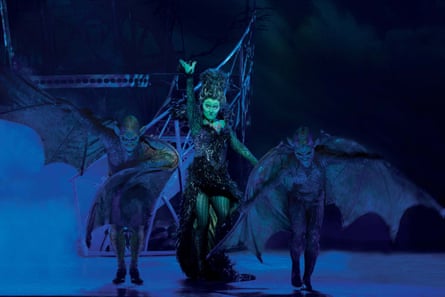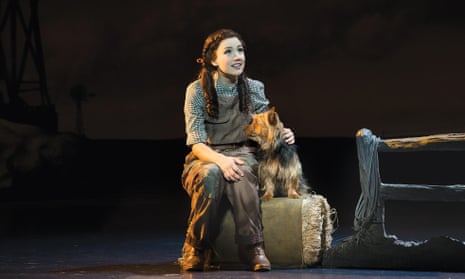When beloved classic films turn into cultural touchstones, they become potential box office gold. The Wizard of Oz is no exception, and at the opening night of the latest stage adaptation, Sydney’s Capitol Theatre is full of Dorothys – some in full costume, others wearing red shoes or clutching plush Totos, and all bubbling with excitement.
Who can blame them? The movie has walked away with so many hearts since 1939, just like the original novels had done almost 40 years earlier. Harold Arlen’s original score is packed with wonder, longing and adventure, and Over the Rainbow was voted the greatest song of the 20th century.
And then there’s the story, which feels embedded in the collective consciousness of the Western world: wilful, wistful Dorothy – trying to find a place to belong in a world that perhaps doesn’t understand her – belongs to all of us, and so does the fantasy land to which she travels and the ideals and life lessons it represents.
That’s why we keep putting it on stage, and in Australia we’ve been here many times before. Reg Livermore played the Wicked Witch at Sydney’s storied and now-lost Tivoli Theatre in 1964, and John Kane’s successful 1987 London adaptation – in which Dorothy and her friends honour a scene cut from the film and dance a magically influenced Jitterbug – first premiered in Australia in 1991, with Pamela Rabe as the Wicked Witch. Kane’s production also formed the basis for The Wizard of Oz on Ice (Sydney and Melbourne, 1997), and toured the country again sans-skates in 2001, starring Nikki Webster.
In this current production, which premiered on the West End in 2011, Andrew Lloyd Webber, Jeremy Sams and Tim Rice have tackled it afresh, fleshing out the film’s score with new, perfectly competent numbers: one to help establish Dorothy’s angst in the beginning of the show; a couple for whichever beloved stage veteran is playing Professor Marvel/The Wizard (in London it was Michael Crawford, and in Australia it’s Anthony Warlow); and one, quite rightly, for the Wicked Witch, to explain her evil plans to the audience. (She rhymes “clueless” with “shoeless”. It almost works.)

Detailed video projections by Jon Driscoll (recreated here by Daniel Brodie) bring the cinema to the stage, and the twister that carries Dorothy to Oz is appropriately impressive; as in the film, we transition from sepia tones to what feels like glorious 1939 Technicolor. Robert Jones’ design is a confection that places the action inside a lit-up rainbow-shaped proscenium; bright colours, oversized flowers, and elaborately gnarled trees seem to leap off the stage.
Of course, Australian box offices have been dominated in the last decade by two national tours of Wicked, the musical that explains the witches’ origin story (its tagline: “so much happened before Dorothy dropped in”). In a cunning casting move, two of those witches appear again here for this “sequel”; Jemma Rix as the Wicked Witch, and Lucy Durack as Glinda the Good. They’re a welcome presence on stage, relishing in the broad theatrics of their characters’ arch rivalry. Usually the villain is the biggest diva, but Durack’s Glinda is a camp, droll delight – there are shades of Megan Mullally in her sugar-coated barbs, and she draws out her lines with pleasure. She’s well-matched by Rix, whose Miss Gulch is wonderfully severe, her Witch an embodiment of that trademark high-pitched cackle.
This production mostly side-steps the sincere and remains playful, leaning on physical comedy, witticisms, and self-referential humour to propel the story forward. When Dorothy (Samantha Dodemaide) tells Scarecrow (the delightfully akimbo Eli Cooper) she’ll miss him most of all, the dejected Tin Man (Alex Rathgeber) and Cowardly Lion (John Xintavelonis) voice their protest, as though honouring decades of snubbed feelings – and when the Wicked Witch shoots off a fireball, she grimaces and tells us it hurt (both Margaret Hamilton and her stand-in were nearly killed by the film’s fireball stunts). And of course there’s plenty of live animal action from Toto, played by terriers Trouble and Flick in Sydney – two very good dogs indeed.
This production has also attempted to course-correct the queer-coded Cowardly Lion of the film into an out-and-proud character; at one point, looking directly at the audience, he tells us he’s “proud to be a friend of Dorothy”. Overplayed, the joke feels less like character redemption and more like the stereotyping has just found an updated justification for its existence.

It’s also hard to ignore that in this staging Dorothy is more catalyst and cipher than she is a fully-fleshed-out character, despite her new song – and it doesn’t help that Dodemaide’s performance is frequently buried under those of the bigger, more exciting personalities. Toto, her faithful partner in crime, has a tendency to steal those scenes out from under her: audiences were riveted on his cute face, well-rehearsed actions, and the potential for adorable, canine-driven chaos. (The show was chaos-free on opening night and Toto hit all of his marks, but every “aww” and audible gasp of delight from the audience belonged to the dog).
Director Jeremy Sams has created a straightforward production, helmed in Australia by Karen Johnson Mortimer, which relies on spectacle to move the story forward. Arlene Phillips’ choreography (supervised here by Lisa O’Dea) feels muted on the Capitol stage (though there’s a baton-dance by the Winkies, arms interlocked, that impresses), and the action breathes easier when the movement is simpler.
Arlen’s original score remains the brightest light of the show, and music supervisor Guy Simpson with musical director Laura Tipoki bring the brightness of the music to the fore, using it to set a jaunty pace; the classic numbers are as vibrant as the set, played with verve by the orchestra and sung with conviction by the cast.
Before the 1939 film begins proper, a note crosses the screen. It reads, in part: “this story has given faithful service to the Young in Heart; and Time has been powerless to put its kindly philosophy out of fashion. To those of you who have been faithful to it in return… we dedicate this picture.”
This sentiment perhaps best captures the spirit of this adaptation: it’s a performance ritual for the faithful. There are no real surprises here; the Wizard of Oz remains the Wizard of Oz. The end result is not magical, but it carries within itself the memory of magic, and it is genuinely enjoyable – and perhaps, for a nostalgia showpiece, that is quite enough.

Comments (…)
Sign in or create your Guardian account to join the discussion